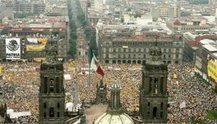 As it turned out, we arrived in Mexico City just a couple weeks after a controversial presidential election. The right wing candidate, Felipe Calderón, is claiming victory with a razor-thin margin of votes (36% to 35%).
As it turned out, we arrived in Mexico City just a couple weeks after a controversial presidential election. The right wing candidate, Felipe Calderón, is claiming victory with a razor-thin margin of votes (36% to 35%).  However, the leftist candidate, Andrés Manuel López Obrador (above center), is claiming fraud. As a result, he organized several giant protests in Mexico City, including one on Sunday, July 16, the last day we were in town. People came from all over the country, and some sources estimated that over 1,100,000 people were packed in to the city center.
However, the leftist candidate, Andrés Manuel López Obrador (above center), is claiming fraud. As a result, he organized several giant protests in Mexico City, including one on Sunday, July 16, the last day we were in town. People came from all over the country, and some sources estimated that over 1,100,000 people were packed in to the city center.  Needless to say, walking around this area was interesting, but quite difficult at times. We never got anywhere near the stage where López Obrador was speaking.
Needless to say, walking around this area was interesting, but quite difficult at times. We never got anywhere near the stage where López Obrador was speaking. Demonstrators streaming past the Palace of Fine Arts after the protest ended.
Demonstrators streaming past the Palace of Fine Arts after the protest ended.
 The large posters in the background are actually protest art. In the poster on the right, the right-wing candidate Felipe Calderón is dubbed "FECAL", which one could assume has the same meaning here as it would in the US.
The large posters in the background are actually protest art. In the poster on the right, the right-wing candidate Felipe Calderón is dubbed "FECAL", which one could assume has the same meaning here as it would in the US. This one says "NO to the f@#%ing fraud". Mexicans definitely aren't shy about profanity.
This one says "NO to the f@#%ing fraud". Mexicans definitely aren't shy about profanity. As of this writing (August 1, 2006), the controversy still hasn't been decided, as the Mexican Supreme court is still debating whether to authorize a complete manual recount of the votes, as López Obrador is demanding. López Obrador has also presented charges and supposedly evidence documenting thousands of irregularities during election day.
None of this comes as a surprise, since electoral fraud is nothing new in Mexico. For instance, it is widely acknowledged by everybody these days that the 1988 election was stolen by the then-governing party (PRI) for their candidate. And, it's worth noting that same party (PRI) ruled the country for (suspiciously enough) more than 70 years continuously.
Anyways, the electoral mess 2006 should be decided once and for all by the first week of September.
Meanwhile...this wraps up our Mexico road-trip! After Mexico City, we were pretty exhausted, fed up with searching for dog-friendly hotels, and anxious to see friends in the US, so we made a 2-day road-warrior marathon beeline to the US. For what it's worth, we crossed the border at noon on Tuesday, July 18, with absolutely no hassle whatsoever.
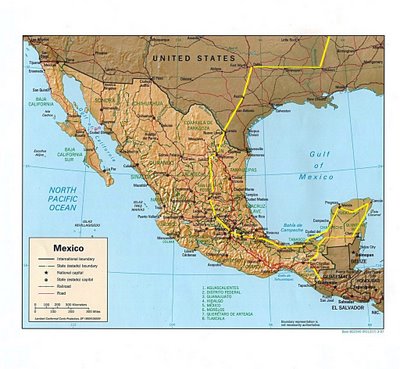 The yellow line roughly traces the route we drove from Guatemala to Mississippi.
The yellow line roughly traces the route we drove from Guatemala to Mississippi.Back to home page
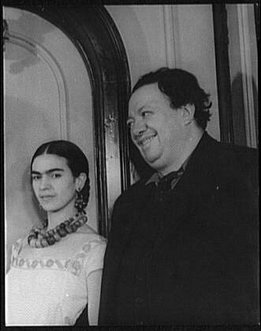 Diego Rivera and Frida Kahlo were at once Mexico's 2 most famous celebrities of all time, and also arguably the 2 greatest painters in the history of the western hemisphere. The fact that they were married (twice) just makes them even more interesting. Plus there are lots of other juicy tidbits, including open bisexuality (Frida), rampant philandering (Diego), and an affair with a famous leader of the 1917 communist revolution in Russia.
Diego Rivera and Frida Kahlo were at once Mexico's 2 most famous celebrities of all time, and also arguably the 2 greatest painters in the history of the western hemisphere. The fact that they were married (twice) just makes them even more interesting. Plus there are lots of other juicy tidbits, including open bisexuality (Frida), rampant philandering (Diego), and an affair with a famous leader of the 1917 communist revolution in Russia.  One of Diego Rivera's most famous murals, "A Dream of a Sunday Afternoon in Alameda Park", has its own museum which was just a couple of blocks from our hotel in Mexico City.
One of Diego Rivera's most famous murals, "A Dream of a Sunday Afternoon in Alameda Park", has its own museum which was just a couple of blocks from our hotel in Mexico City. In one of the most famous incidents, he was commissioned by Nelson Rockefeller to do a 63-foot by 17-foot mural inside Rockefeller Center in New York City. In the photo above, Diego is working at the Rockefeller Center. In the end, however, Rockefeller banned him from finishing the mural and quickly destroyed it because he had included an image of the communist leader Lenin among a group of US founding fathers.
In one of the most famous incidents, he was commissioned by Nelson Rockefeller to do a 63-foot by 17-foot mural inside Rockefeller Center in New York City. In the photo above, Diego is working at the Rockefeller Center. In the end, however, Rockefeller banned him from finishing the mural and quickly destroyed it because he had included an image of the communist leader Lenin among a group of US founding fathers. 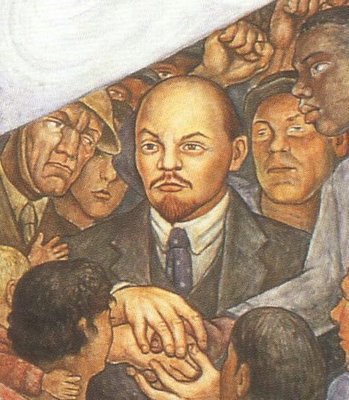 In Diego's Rockefeller Center mural, Lenin was symbolically clasping the hands of a black American, a white Russian soldier, and a worker, as allies of the future.
In Diego's Rockefeller Center mural, Lenin was symbolically clasping the hands of a black American, a white Russian soldier, and a worker, as allies of the future. 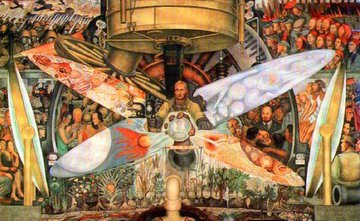 After the Rockefeller Center mural was destroyed, Diego eventually recreated the mural (Lenin included) in Mexico City and titled it "Man, Controller of the Universe".
After the Rockefeller Center mural was destroyed, Diego eventually recreated the mural (Lenin included) in Mexico City and titled it "Man, Controller of the Universe". 
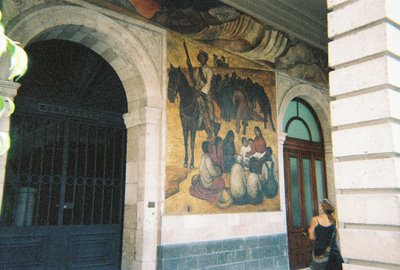

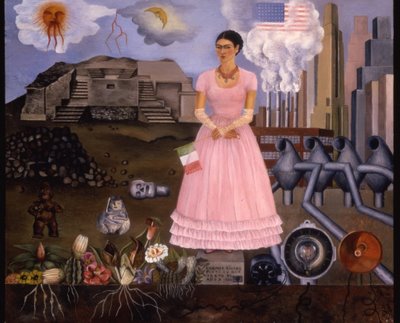

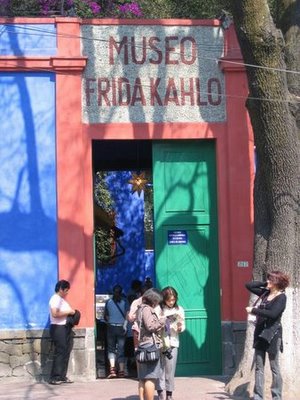

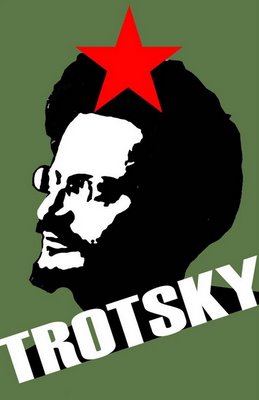 So what is Leon Trotsky doing on a page about art museums? If you'll remember from your high-school history class, Trotsky was one of the 3 leaders (along with Lenin and Stalin) of the 1917 communist revolution in Russia. Well after Lenin died, Stalin turned against Trotsky and had him exiled.
So what is Leon Trotsky doing on a page about art museums? If you'll remember from your high-school history class, Trotsky was one of the 3 leaders (along with Lenin and Stalin) of the 1917 communist revolution in Russia. Well after Lenin died, Stalin turned against Trotsky and had him exiled. 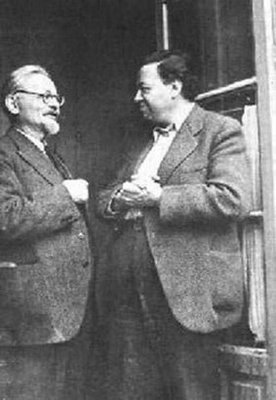 Before too long, Trotsky ended up here in Mexico City, where he was befriended by Diego and Frida, who (as you might have guessed) were both avid communist supporters. During his stay in their house, Frida and Trotsky even had an affair.
Before too long, Trotsky ended up here in Mexico City, where he was befriended by Diego and Frida, who (as you might have guessed) were both avid communist supporters. During his stay in their house, Frida and Trotsky even had an affair. 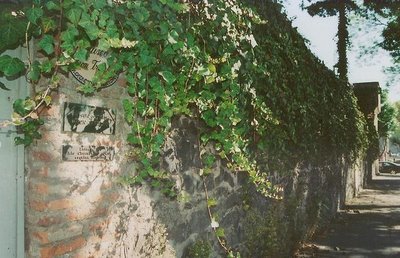
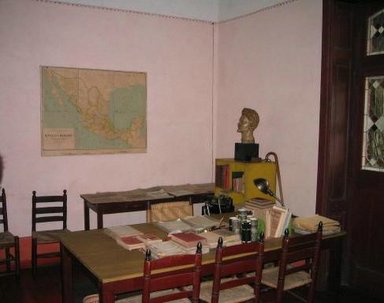 Finally in the summer of 1940, a secret agent of Stalin (who had befriended Trotsky) killed him in his home office (above) by burying an ice pick in his head.
Finally in the summer of 1940, a secret agent of Stalin (who had befriended Trotsky) killed him in his home office (above) by burying an ice pick in his head. 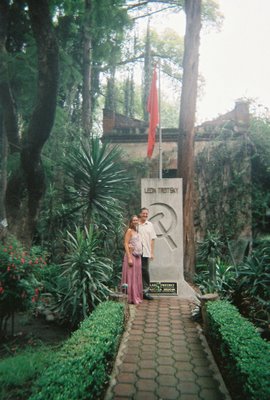






 This city, then called Tenochtitlan, was in fact the capital city of the legendary Aztec empire, then called Mexíca by the Aztecs. As you can see from the artist's rendition above, it was surrounded by a large lake. (The lake has been almost completely dried up for several hundred years now, and all that remains today are some canals in one of the outer districts.)
This city, then called Tenochtitlan, was in fact the capital city of the legendary Aztec empire, then called Mexíca by the Aztecs. As you can see from the artist's rendition above, it was surrounded by a large lake. (The lake has been almost completely dried up for several hundred years now, and all that remains today are some canals in one of the outer districts.)  In fact, the heart of modern day Mexico City was the heart of the ancient Aztec empire, and unlike in other countries of the western hemisphere, the history of the indigenous people prior to the arrival of the Europeans is still a vibrant part of the entire national identity.
In fact, the heart of modern day Mexico City was the heart of the ancient Aztec empire, and unlike in other countries of the western hemisphere, the history of the indigenous people prior to the arrival of the Europeans is still a vibrant part of the entire national identity.

 The highlight of our return trip through Mexico was undoubtedly the capital, Mexico City, which is known by Mexicans as D.F. (kind of like the U.S. capital is known as D.C., however D.F stands for Distrito Federal),
The highlight of our return trip through Mexico was undoubtedly the capital, Mexico City, which is known by Mexicans as D.F. (kind of like the U.S. capital is known as D.C., however D.F stands for Distrito Federal), 













